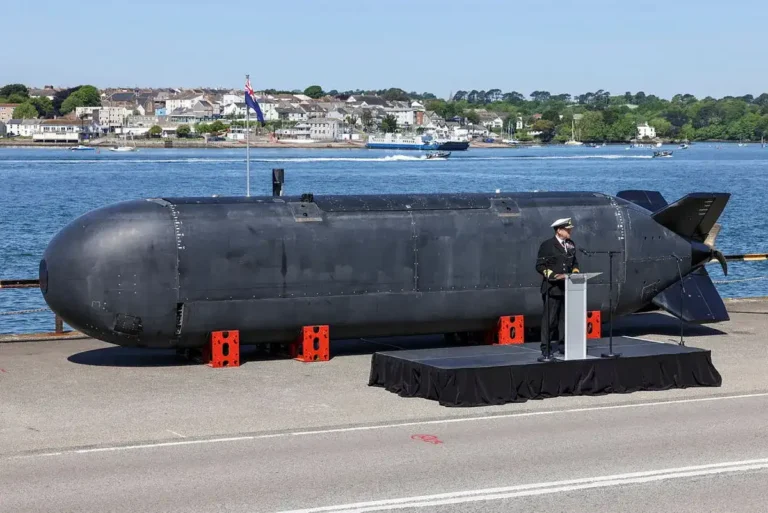Follow Us:

Share
China’s most advanced aircraft carrier, the Fujian, has officially set sail for its first sea trials, marking a significant step in its military expansion. Footage shared by Clash Report captured the massive warship departing from dry dock at Shanghai’s Jiangnan Shipyard and smoothly entering open waters. This moment is not just a technical milestone but also a powerful statement of China’s growing influence in naval warfare.
The Fujian aircraft carrier begins sea trials, showcasing its status as the country’s largest and most advanced carrier to date. Unlike its predecessors, the Liaoning and Shandong, which rely on ski-jump ramps, the Fujian is equipped with electromagnetic catapults (EMALS)—a cutting-edge technology that places it in the same league as the U.S. Navy’s Gerald R. Ford-class carriers. With this system, the Fujian aircraft carrier begins sea trials with the ability to launch heavier aircraft with more fuel and weapons, drastically improving China’s power projection capabilities.
🇨🇳The Fujian, China's third aircraft carrier and the first of its Type 003 class has left dry dock today and began sea trials. pic.twitter.com/jhHFnoNAZ4
— WORLD AT WAR (@World_At_War_6) February 18, 2025
The Fujian’s journey from dry dock to open watermarks the start of a series of rigorous tests that will determine its operational readiness. The initial phase of the trials is focused on propulsion, electrical systems, and maneuverability, ensuring that the massive vessel—displacing nearly 80,000 tons—can perform smoothly under real-world conditions. Engineers will assess its ability to navigate confined waters, conduct sharp turns, and operate in adverse weather. These trials will also evaluate the ship’s stability and control, critical for future combat operations.
As testing progresses, later phases will introduce more complex assessments, including the integration of aircraft operations. The Fujian is expected to accommodate 40 to 70 aircraft, including the J-15 carrier-based fighter, the next-generation J-35 stealth fighter, and the KJ-600 early warning aircraft.

A key focus will be on how efficiently the carrier can launch and recover aircraft, particularly using its advanced catapult-assisted takeoff and arrestor landing system. These tests are essential to ensure that the carrier can maintain a high operational tempo, a crucial factor in modern naval warfare.
Beyond flight operations, the trials will also examine the carrier’s defensive and communication systems. The Fujian is equipped with cutting-edge phased-array radar technology, providing long-range detection and enhanced situational awareness.
Defensive measures include the HQ-10 surface-to-air missile system and the Type 1130 close-in weapon system (CIWS), which are designed to counter aerial threats such as enemy aircraft and incoming missiles. Communication and coordination between the carrier, escort ships, and other naval units will also be tested, ensuring seamless integration into China’s growing carrier strike groups.
The launch of the Fujian aircraft carrier represents a major shift in the balance of naval power in the Asia-Pacific. For decades, the U.S. Navy has dominated the region with its fleet of nuclear-powered aircraft carriers, but China is quickly narrowing the gap. With the Fujian’s advanced technology, Beijing is positioning itself as a formidable naval force, capable of challenging U.S. dominance in strategic waterways such as the South China Sea and Taiwan Strait.
Regional powers, including Japan, India, and Australia, are closely monitoring China’s carrier developments, as the Fujian could significantly alter security dynamics in the Indo-Pacific. The carrier’s ability to project power far beyond Chinese waters means that Beijing can enforce maritime claims, deter adversaries, and support long-range naval operations. This development also underscores China’s long-term ambition of building a blue-water navy capable of global operations, a goal that has become increasingly clear in recent years.
With several months of sea trials ahead, military analysts will be watching closely to see how Fujian performs under real-world conditions. If successful, the carrier is expected to be fully operational by 2026, marking a new era for China’s naval capabilities. As the Fujian undergoes rigorous testing, its impact on regional security, global naval strategy, and China’s military ambitions will be closely scrutinized by military experts and world governments alike.
Share
Defense Feeds is publication focusing on informing, engaging, and empowering the world by providing accurate information from defense technology.
Powered by Defense Feeds © 2025 – All rights reserved.